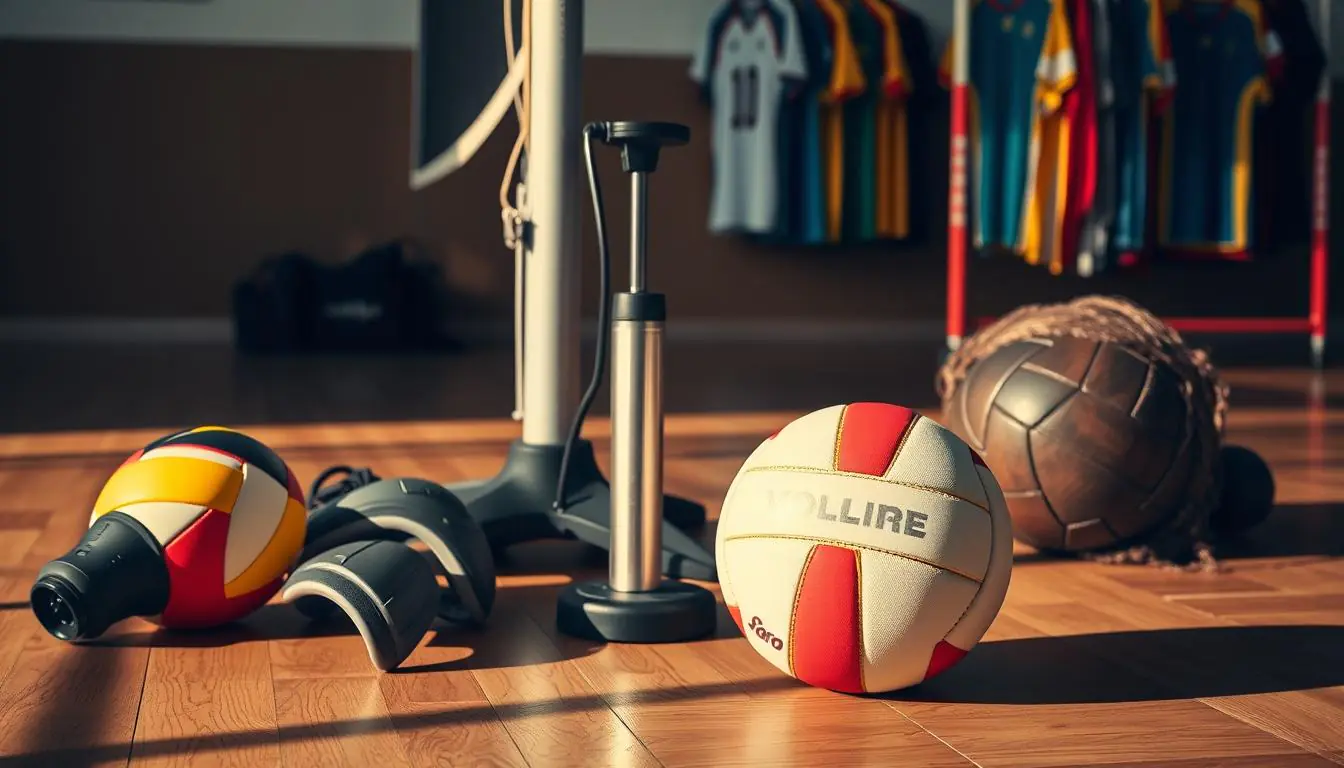When I first stepped onto the volleyball court, I realized success isn’t just about talent. It’s about having the right gear. My journey showed me that the right equipment can turn an average player into a standout.
The world of volleyball training tools is full of innovative solutions. From beginner to advanced levels, there’s equipment for everyone. For example, the Trainer+ Volleyball Target offers two hoops and mesh nets for effective skill development.
Investing in quality volleyball training equipment is a big deal. It’s a commitment to your athletic growth. Whether you’re working on serves, vertical leap, or defensive skills, the right gear matters a lot.
Key Takeaways
- Quality volleyball training gear is essential for skill development
- Equipment ranges from basic tools to advanced training systems
- Targeted practice tools can significantly improve performance
- Versatile training equipment suits multiple skill levels
- Proper gear helps prevent injuries and enhance technique
Understanding Basic Volleyball Equipment Needs
As a volleyball fan, I’ve found that the right gear is key for both indoor and outdoor play. The volleyball world can be complex, but knowing the difference between indoor and outdoor gear helps a lot.
Players need to think about a few important things when choosing equipment:
- Playing environment (indoor vs outdoor)
- Skill level and training goals
- Budget constraints
- Durability of equipment
Indoor vs Outdoor Equipment Requirements
Indoor and outdoor volleyballs are different. Indoor volleyballs have softer synthetic leather for smooth courts. Outdoor volleyballs are tougher for rough surfaces like sand or grass.
Quality Standards for Training Gear
Quality is important in volleyball equipment. Most players use volleyballs made of synthetic leather for about 80% of their games. A good volleyball lasts 1-2 years with regular play.
Budget Considerations for Players
You don’t have to spend a lot on volleyball gear. There are great options at different prices. Focus on what’s essential for performance and durability. Look at material quality, brand, and your training needs.
Pro tip: Always test equipment before making a final purchase to ensure it meets your specific training requirements.
Fundamental Training Balls and Their Specifications
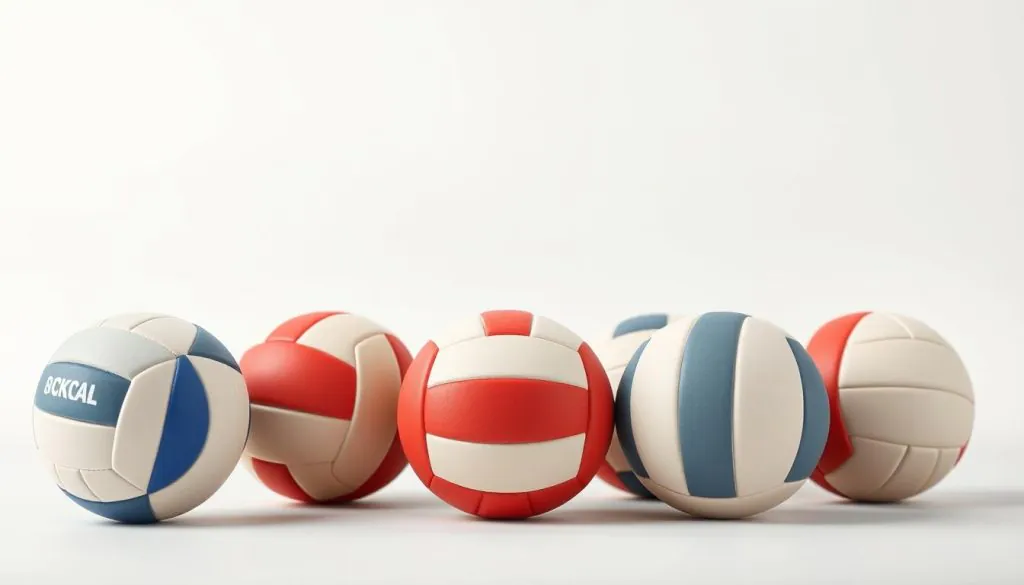
Choosing the right volleyball training balls is key for improving your skills. Not all volleyballs are the same. Knowing the volleyball specifications can really help your training.
When picking volleyball training balls, players should look at a few important things:
- Weight and material that match your skill level
- The right size for your age and level
- Durability for many practice sessions
I suggest focusing on three main types of training balls:
- Lightweight beginner balls for learning new skills
- Standard training volleyballs for those in the middle
- Top-level competition volleyballs
Professional volleyball specs usually include:
- Regulation circumference of 65-67 cm
- Weight between 260-280 grams
- Synthetic leather or microfiber cover
My experience shows that high-quality training balls speed up skill growth. Coaches say players using special gear get better faster at serving, setting, and spiking.
Quality is more important than quantity when choosing volleyball training gear.
Advanced Volleyball Training Equipment for Skill Development
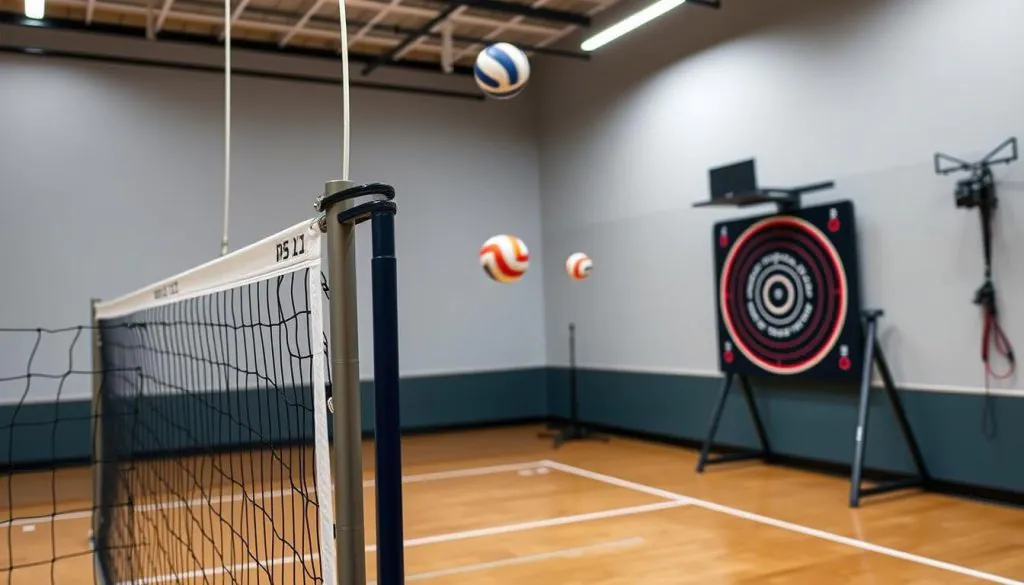
To improve your volleyball game, you need top-notch training tools. These tools can turn regular practice into a pro-level workout. They help you reach new heights in your skills.
Top players know that the right training tools are key. They help you grow your skills. Let’s explore some of the latest tools to boost your volleyball game.
Attack Training Machines
Attack training machines are at the top of the list for improving your game. The Total Attack Volleyball Training Machine is a standout. It offers:
- Serves up to 90 MPH
- Simulates professional-level jump serves
- Ideal for high-level collegiate and professional teams
Setting and Passing Tools
Accuracy is vital in volleyball. Tools like the Spectrum Volleyball Precision Trainer help you hone your skills:
- Adjustable height for all skill levels
- Improves bumping, passing, and setting skills
- Provides consistent training experience
Specialized Practice Nets
Practice nets are key for focused skill improvement. The PowerNet Volleyball Net offers top-notch training features:
- Adjustable to regulation height
- Suitable for men’s and women’s volleyball
- Durable construction for intense training sessions
Using advanced training tools changes your volleyball journey. They help you develop skills like a pro with focused, effective practice.
Essential Net Systems and Setup Equipment
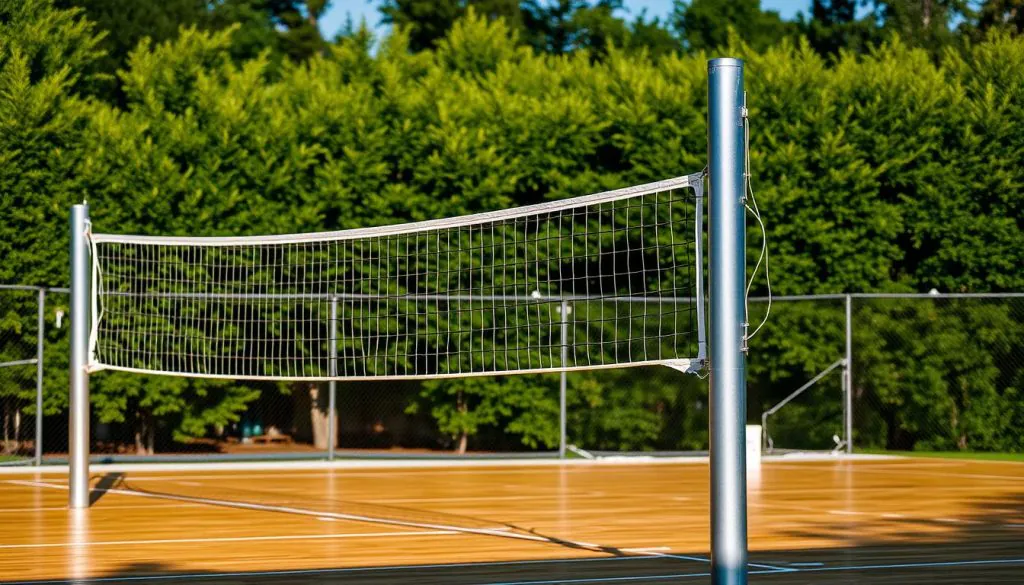
Creating a top-notch volleyball training area starts with the right net systems and court equipment. Quality nets are key, giving athletes a solid place to practice. They make sure every session is professional and reliable.
When picking out volleyball net systems, focus on a few important things:
- Durable pole materials like aluminum or carbon fiber
- High-tension polyethylene or nylon nets
- Regulation-compliant antennas
- Customizable pole padding
- Versatile anchoring systems
Sports Imports is a leader in the market, with over 68,000 volleyball net systems sold. Their carbon poles are 59% stronger than others, used at 93% of Division 1 colleges. Their aluminum poles are light, weighing just 33 lbs, and come with a 25-year warranty.
When choosing court setup equipment, keep these points in mind:
- Net height adjustability for different athlete groups
- Easy installation mechanisms
- Safety features like pole padding
- Compatibility with existing training spaces
High-quality net systems mean safe, consistent, and professional training for volleyball players at every level.
Professional-Grade Target Training Tools
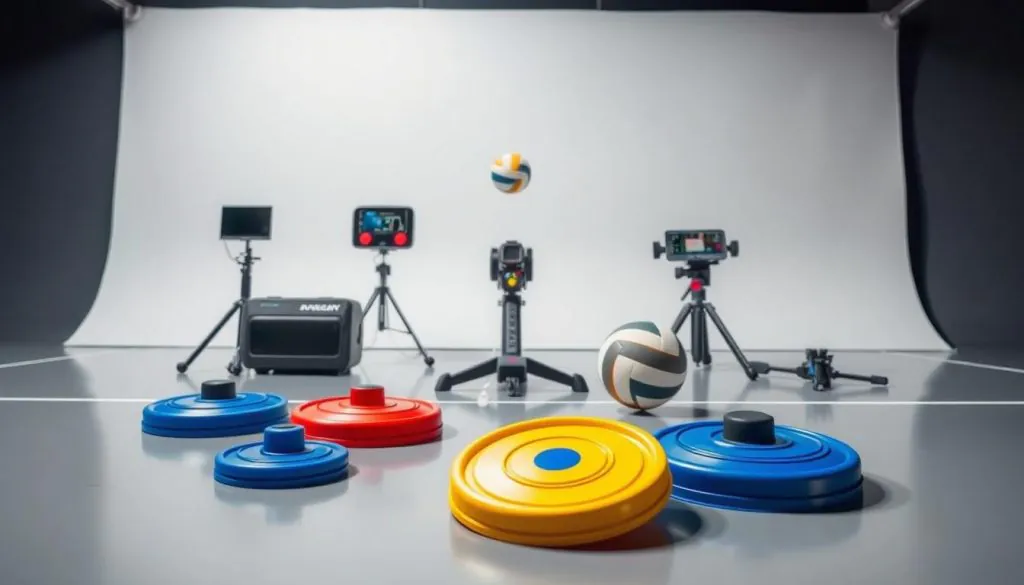
Volleyball players looking to get better need special training tools. These tools help them improve their aim and technique on the court. They are designed to challenge athletes and push their skills higher.
Professional-grade tools turn regular practice into a chance to build skills. They help players get better at muscle memory and aim. This is true for serves, passes, and attacks.
Net Zone Systems
Net zone systems have visual targets for players to aim at. They help athletes:
- Improve serve placement
- Develop strategic court positioning
- Enhance overall shot accuracy
Precision Trainers
The Trainer+ is a top choice for volleyball training. Endorsed by Stanford University’s star setter Kami Miner, it offers flexible training options.
| Feature | Benefits |
|---|---|
| Adjustable Settings | Customized training experiences |
| Portable Design | Use in home, park, or gym |
| Multiple Attachments | Versatile drill options |
Pass Catchers
Pass catchers are key for solo or small group practice. They help athletes work on passing by providing consistent targets. This gives them immediate feedback on their ball control.
Strength and Conditioning Equipment for Volleyball Players
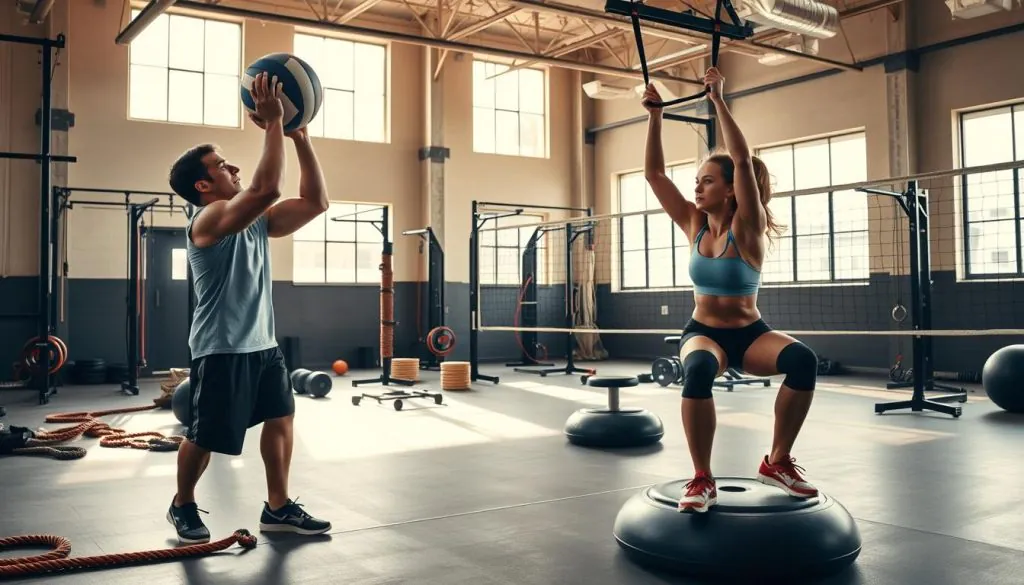
Volleyball strength training needs special equipment. It helps players get explosive power, agility, and strong muscles. As a volleyball athlete, I know how important the right tools are for better performance.
Key conditioning equipment for volleyball players includes:
- Resistance bands for flexibility and muscle activation
- Plyometric boxes for explosive jump training
- Medicine balls for core and upper body strength
- Weighted vests for added resistance training
The VertiMax platforms are top-notch for volleyball athletes. They offer full strength development in many ways:
| Training Component | Benefit for Volleyball |
|---|---|
| Vertical Jump Power | Improves spiking and blocking height |
| Lateral Agility | Enhances defensive positioning |
| Horizontal Speed | Increases court movement efficiency |
Professional athletes like Taylor Pischke, a two-time Olympian, use advanced training. They use tools like VertiMax to boost explosive power. This is key for serving, spiking, and quick movements during games.
The off-season is the best time to build strength and lower injury risks. Using different conditioning equipment in your training will help you become a better volleyball player.
Blocking and Defense Training Equipment
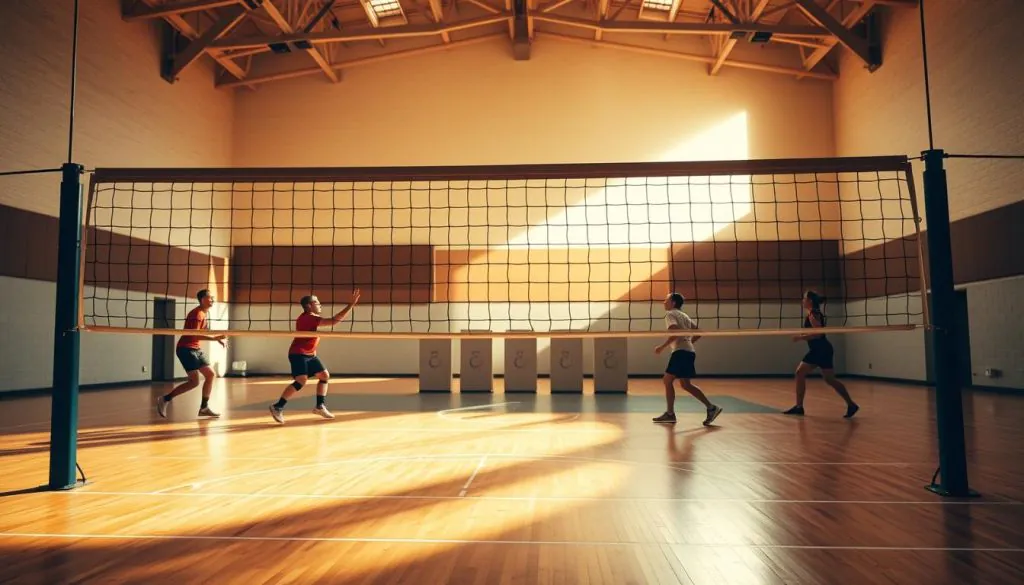
Developing top-notch blocking and defensive skills is key for volleyball players. I’ll show you the best volleyball blocking equipment and defensive training tools. These can change your game for the better.
Volleyball defense needs precision, quick reflexes, and smart training. The right gear helps players build muscle memory and learn vital defensive moves.
Block Blasters: Simulating Real-Game Challenges
Block blasters are new training tools for better blocking skills. They offer real attack simulations. This helps players:
- Practice hand positioning
- Improve timing
- Develop muscle memory for blocking
- Enhance reaction speed
Quad Blockers: Advanced Defensive Training
Quad blockers take defensive training to the next level. They create complex blocking scenarios. Players must:
- Navigate multiple blocking angles
- Improve lateral movement
- Develop strategic blocking techniques
Training Towers: Height and Precision Practice
Training towers are vital for defensive training. They help players block against taller opponents. The VertiMax V8 platform and Raptor are great for improving blocking and defending skills.
Key benefits of these towers include:
- Improving vertical jump
- Enhancing lateral agility
- Building lower body strength
- Developing quick footwork
Pro tip: Regular practice with these volleyball blocking equipment and defensive training tools can greatly boost your performance on the court.
Ball Control and Handling Training Aids
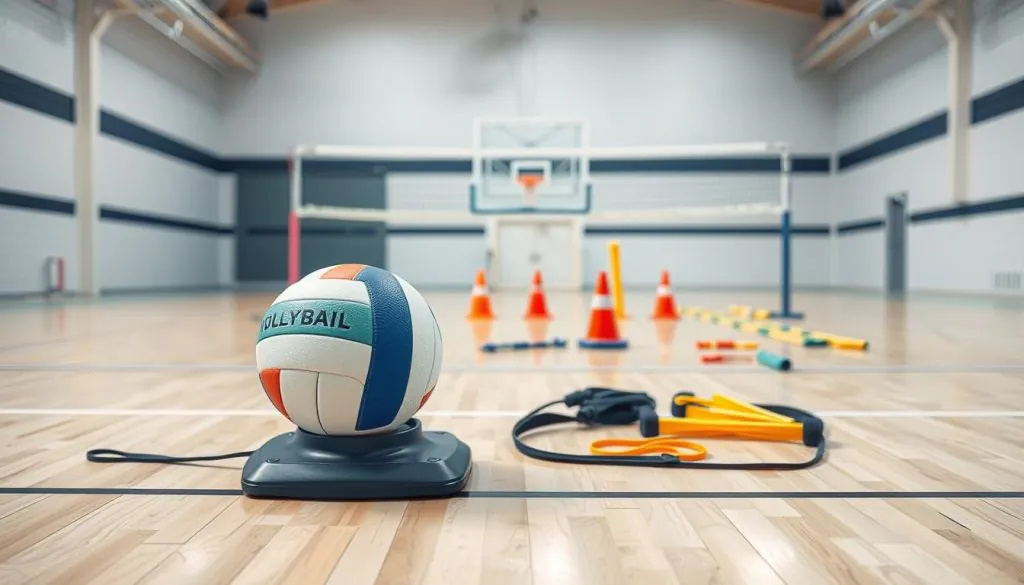
Mastering volleyball ball control is key to being a top player. I’ve found some great tools that can really boost your skills. These tools help you control the ball better and be more precise.
To get better at handling the ball, you need the right practice tools. Here are some top picks:
- Weighted volleyballs to enhance arm strength and control
- Rebound nets for improving passing techniques
- Wall-mounted targets for precision training
- Specialized gloves to improve hand sensitivity
Improving ball control takes regular practice with the right gear. Some of my top picks include:
- Volleyball Pal – A compact training device priced at $29.95
- Wall Mount Spike Trainer – Helps develop accurate striking techniques
- Mikasa MVA300 Attach Training Ball – Designed for specialized handling drills
“The secret to great volleyball is not just skill, but consistent, targeted practice with the right handling training equipment.” – Volleyball Training Pro
Professional players use special tools to improve their ball control. These tools help build muscle memory and precision. This makes a big difference in how you play in matches.
When choosing ball control equipment, think about durability, purpose, and your skill level. Each tool has its own benefits. They help improve your touch, hand-eye coordination, and confidence.
Storage and Maintenance Solutions for Volleyball Training Equipment
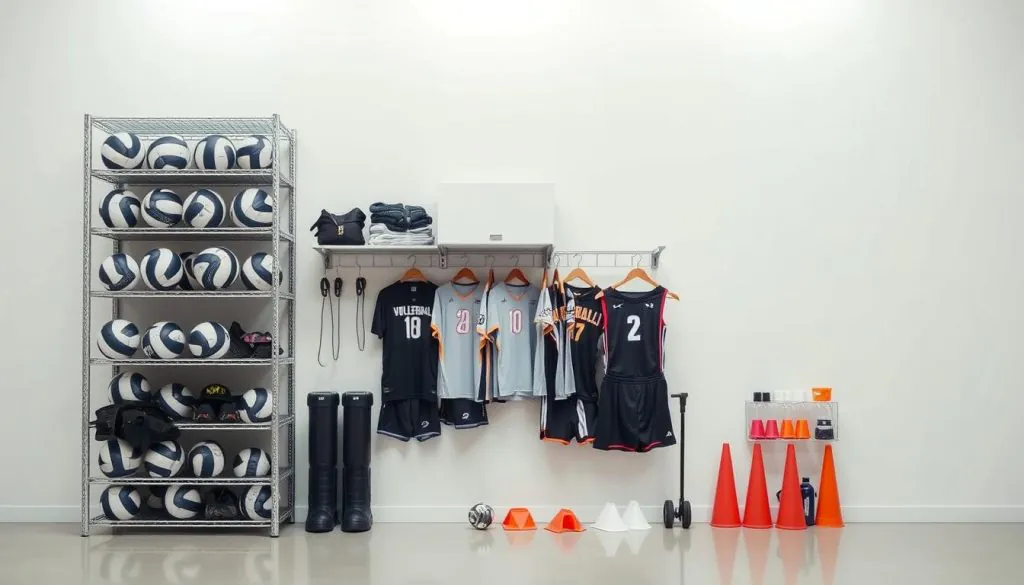
Keeping your volleyball gear safe is key to better performance and longer life. The right storage and care can make your equipment last longer. This could save you up to 30% on buying new stuff.
Good storage means knowing what your gear needs. I’ll share some top tips to keep your equipment in great shape.
Equipment Organization Systems
Organizing your gear can make your training area better and protect your stuff. Here are some storage ideas:
- Wheeled ball carts for easy moving
- Wall-mounted racks for nets and poles
- Climate-controlled storage cabinets
- Multi-purpose equipment caddies
Protective Covers and Cases
Get top-notch protective gear to keep your equipment safe. Professional-grade covers can cut down on damage by up to 50%. Look for:
- Padded volleyball machine covers
- Water-resistant net storage bags
- Breathable equipment cases
Maintenance Tools and Practices
Regular care is vital for your volleyball gear. My must-have tools include:
- Ball pressure gauge
- Cleaning supplies
- Net repair kit
- Pole and frame inspection tools
Pro Tip: Make a monthly maintenance plan. Check and clean your volleyball gear to keep it in top shape.
Using these storage and care tips will help protect your investment. Your training tools will stay in great condition for many years.
Conclusion
As a volleyball fan, I’ve found that choosing the right equipment is vital. The right gear can make your practice sessions stand out. Tools like volleyball training machines help you practice thousands of times, speeding up your skill growth.
Buying top-notch training equipment is more than just a purchase. It’s about picking tools that grow with you. From machines that mimic game serves to systems for solo practice, today’s tech offers great chances for improvement.
Your volleyball path is unique, and your gear should match. By picking the right equipment, you create a plan just for you. Remember, while gear is important, it’s your hard work that truly matters.
As you keep improving in volleyball, see each piece of equipment as an investment in your future. Whether you’re in high school or aiming for college, the right tools can help you reach your goals.
FAQ
What types of volleyball training balls are best for beginners?
Beginners should use lightweight training balls. These help you learn the right techniques without getting tired. Look for balls that are a bit softer and lighter. They make serving, setting, and passing easier and more fun.
How often should I replace my volleyball training equipment?
How long your gear lasts depends on how often you use it. Volleyballs usually need a new one every 6-12 months. Nets and other durable items can last for years. Check your gear for damage like loose stitching or holes. Replace anything that might hurt your training or safety.
What’s the difference between indoor and outdoor volleyball equipment?
Indoor volleyballs are softer and made for court play. Outdoor ones are tougher for playing on sand or grass. Nets and shoes also change, with outdoor ones being more durable.
Do I need expensive equipment to improve my volleyball skills?
No, you don’t need to spend a lot. Basic tools like targets, resistance bands, and volleyballs are enough. What’s more important is practicing regularly and using the right techniques.
How can I practice volleyball skills at home?
You can practice at home with little gear. Use wall targets for passing and setting, and resistance bands for strength. Solo rebound nets help with ball control. Watching videos and doing footwork drills also improve your skills.
What protective gear is recommended for volleyball training?
You need knee pads for dives and falls, good shoes for support, and optional compression clothes for muscle safety. Serious players might also use ankle braces and special volleyball shoes for more protection and performance.
How do I choose the right volleyball net for training?
Look at portability, height adjustability, and durability. Portable nets are good for home and outdoor, while fixed ones are better for indoor use. Make sure the net is the right height (7’4¼” for men, 7′ for women) and made of durable materials.
What strength training equipment is most effective for volleyball players?
Key tools include resistance bands, plyometric boxes, medicine balls, and weighted vests. They help build explosive power, core strength, and sport-specific strength for serving, spiking, and quick movements.
Are attack training machines worth the investment?
Yes, for serious players and teams, attack training machines are very valuable. They offer different serve and spike scenarios for practicing defense and improving reaction times. They’re pricey but provide focused training hard to get from regular methods.
How can I maintain my volleyball training equipment?
Clean balls with the right solutions, store in cool, dry places, and use covers. Check for wear and tear often. Keep a ball pump ready, store nets and poles right, and inspect before and after training. This keeps your gear in good shape and working well.
